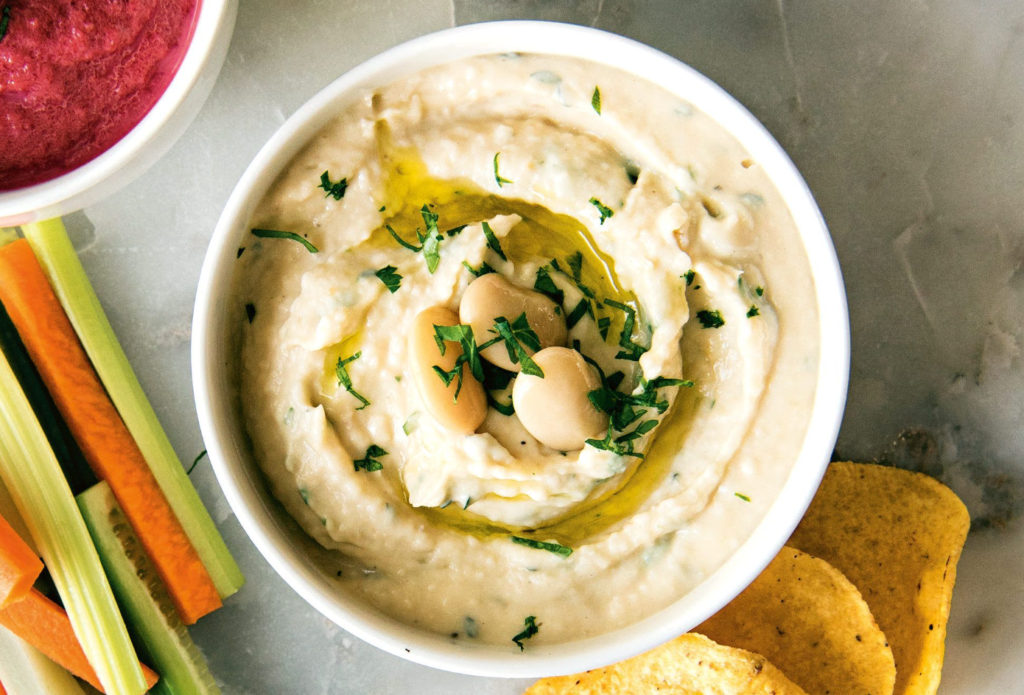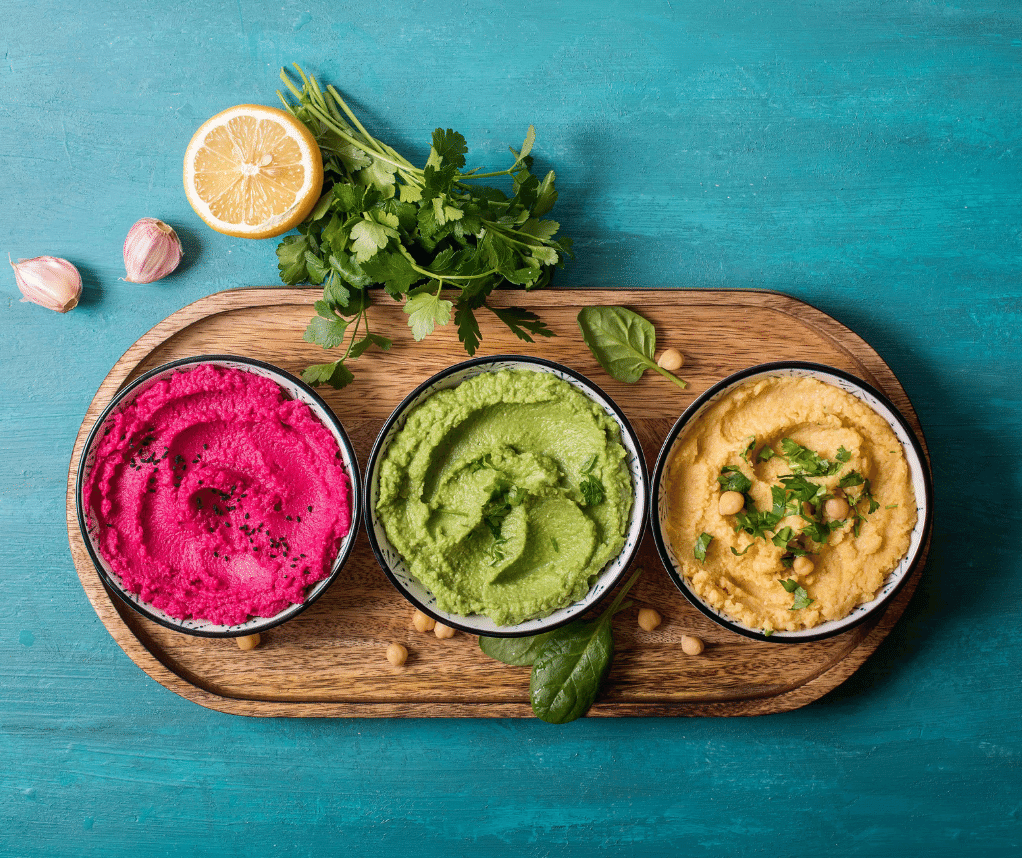Enjoyed this recipe? Share the love!
Introduction:
Hummus is a healthy, delicious dip made from chickpeas, tahini, olive oil, and lemon juice. This classic Middle Eastern dip is perfect for pairing with fresh vegetables, pita bread, or crackers. It’s a versatile and nutrient-rich snack option that’s easy to prepare and great for both casual snacking and elegant appetizers. Hummus is high in protein, healthy fats, and fiber, making it a filling yet light choice for any time of the day.
Whether you’re looking for a quick snack or a party dish, hummus offers a creamy and flavorful option that’s sure to please.

Ingredients:
For 4 servings:
- 1 can (15 oz) chickpeas, drained and rinsed
- 2 tablespoons tahini
- 2 tablespoons olive oil
- 1 garlic clove, minced
- Juice of 1 lemon
- Salt and pepper to taste
- 2-3 tablespoons water (optional for thinning)
- Paprika or olive oil for garnish (optional)
Instructions:
- Blend the chickpeas: In a food processor, add the drained chickpeas, tahini, olive oil, garlic, and lemon juice.
- Blend until smooth: Process the mixture until smooth, adding water one tablespoon at a time until the desired consistency is reached.
- Season: Add salt and pepper to taste, blending again for consistency.
- Serve: Spoon the hummus into a serving bowl and drizzle with extra olive oil or sprinkle paprika on top for garnish.
- Enjoy: Serve with fresh veggies, pita chips, or use as a sandwich spread.

Nutritional Benefits:
Hummus is an excellent source of plant-based protein and healthy fats. Chickpeas provide fiber, which aids digestion, while tahini and olive oil add healthy fats, making hummus both satisfying and heart-healthy. It’s a nutritious choice for vegans, vegetarians, or anyone looking for a filling snack.
Serving Suggestions:
Hummus pairs wonderfully with veggie sticks, pita bread, or crackers. You can also use it as a spread in sandwiches or wraps, or as a base for a healthy grain bowl. For added flavor, garnish your hummus with a sprinkle of paprika, cumin, or a drizzle of olive oil.
Hummus is a versatile and healthy dip that’s quick to make and perfect for any occasion. Whether you’re snacking, hosting, or looking for a nutritious spread, this easy hummus recipe offers delicious flavor and plenty of health benefits.

Tips for Making Perfect Hummus
- Use High-Quality Tahini
Tahini is a key ingredient that contributes to the creamy texture and rich flavor of hummus. Choose a high-quality, smooth tahini made from 100% sesame seeds. Some tahinis can be bitter, so if you’re new to tahini, taste a small amount to make sure it’s fresh and mild. - Cook the Chickpeas Well
For the creamiest hummus, use chickpeas that are well-cooked and soft. If using canned chickpeas, simmer them in water for 10–15 minutes until very tender. This step helps make the hummus extra smooth and reduces any graininess. - Peel the Chickpeas for Ultra-Smooth Texture
Removing the skins from chickpeas creates an extra-smooth, luxurious hummus. To do this quickly, rub the chickpeas gently between your fingers or in a clean kitchen towel, then discard the skins. While optional, this step makes a noticeable difference. - Add Ice Water for Creaminess
Adding ice-cold water while blending can help achieve a lighter, fluffier texture. Add one tablespoon of ice water at a time until the hummus reaches your preferred consistency. - Adjust Flavors to Taste
Taste the hummus before serving and adjust the salt, lemon juice, or tahini to your preference. Some people prefer a more lemony hummus, while others like it creamier or saltier. Experiment with the ratios to find your perfect balance.
Delicious Variations of Hummus
- Roasted Red Pepper Hummus
Blend in roasted red peppers for a slightly sweet and smoky flavor. Roasted red pepper hummus is a beautiful reddish color and pairs well with fresh vegetables and pita chips. - Garlic Hummus
If you love garlic, add an extra clove or two, or roast the garlic before blending for a milder, sweeter taste. Roasted garlic brings a deep flavor that complements the chickpeas and tahini perfectly. - Spicy Hummus
Add a dash of cayenne pepper, red chili flakes, or a small piece of fresh jalapeño to the blender for a spicy kick. Adjust the heat level to your liking and garnish with extra chili flakes for added heat. - Herb Hummus
Blend fresh herbs like parsley, cilantro, or basil into the hummus for a green, herbaceous flavor. This variation is perfect for adding a burst of freshness and pairs well with Mediterranean dishes. - Sun-Dried Tomato Hummus
Add a few sun-dried tomatoes to the blender for a tangy, rich flavor. Sun-dried tomatoes bring a unique depth and a slightly chewy texture that contrasts nicely with the creamy hummus. - Avocado Hummus
Blend a ripe avocado into the hummus for an extra creamy texture and a subtle avocado flavor. Avocado hummus is especially smooth and adds healthy fats, making it a filling, nutrient-rich dip. - Beet Hummus
For a vibrant pink color and a touch of earthiness, add cooked or roasted beets to the blender. Beet hummus is visually stunning and packed with nutrients, making it a great option for parties or potlucks.
Health Benefits of Hummus
- High in Plant-Based Protein
Chickpeas are a great source of plant-based protein, making hummus an excellent choice for vegetarians and vegans. Protein helps keep you full and is essential for muscle health and tissue repair. - Rich in Fiber for Digestive Health
The fiber in chickpeas aids digestion and promotes a healthy gut. Fiber also helps regulate blood sugar and keeps you full for longer, making hummus a satisfying, low-calorie snack. - Heart-Healthy Fats from Tahini and Olive Oil
Both tahini and olive oil are sources of monounsaturated fats, which support heart health by lowering bad cholesterol levels. These healthy fats are also beneficial for skin health and reduce inflammation. - Packed with Vitamins and Minerals
Hummus is a good source of essential vitamins and minerals, including folate, iron, magnesium, and zinc. Folate is important for cell health, while iron supports energy levels and immune function. - Contains Antioxidants
Ingredients like garlic and olive oil contain antioxidants that protect cells from damage and reduce inflammation. Antioxidants also support skin health and may help reduce the risk of chronic diseases. - Low Glycemic Index
Chickpeas have a low glycemic index, which means they release energy slowly and help prevent blood sugar spikes. This makes hummus a great choice for those looking to manage blood sugar levels.
Creative Serving Suggestions
- Serve with Fresh Vegetables
Hummus pairs well with an assortment of fresh veggies like cucumber, bell pepper, carrot sticks, celery, and cherry tomatoes. This makes for a healthy, low-calorie snack that’s colorful and full of nutrients. - Use as a Sandwich Spread
Swap out mayonnaise or other spreads for hummus in sandwiches or wraps. It adds flavor and creaminess while providing extra protein and fiber, making sandwiches more filling and nutritious. - Top a Grain Bowl
Add a scoop of hummus to your favorite grain bowl with quinoa, roasted vegetables, and greens. Hummus adds flavor and creamy texture, transforming a simple bowl into a satisfying meal. - Serve with Pita Chips or Flatbread
Toasted pita chips or warm flatbread are classic pairings with hummus. They add a satisfying crunch and make for a perfect appetizer or snack that’s easy to share. - As a Side for Grilled Meats or Falafel
Hummus complements grilled chicken, lamb, or beef as well as falafel, making it an ideal dip for Mediterranean and Middle Eastern meals. It balances rich flavors and adds moisture to each bite. - As a Salad Dressing Base
Mix hummus with a bit of water, lemon juice, or vinegar to create a creamy salad dressing. This works especially well with Mediterranean-inspired salads that include ingredients like cucumbers, olives, and feta cheese.
Advanced Preparation Techniques
- Soak and Cook Dried Chickpeas
For the freshest, most flavorful hummus, use dried chickpeas instead of canned. Soak them overnight, then cook until tender. Using dried chickpeas results in a deeper flavor and a more authentic texture. - Peel Chickpeas for Extra Creaminess
Removing the skins from chickpeas creates an exceptionally smooth texture. After cooking, rub the chickpeas between a towel or use your hands to gently remove the skins. This step can take a bit of time but results in the creamiest hummus. - Add Ice Water for a Light Texture
Ice water can help create a fluffy texture by emulsifying the tahini with the other ingredients. Adding it slowly while blending makes the hummus airy and light. - Blitz the Tahini and Lemon Juice First
Blend the tahini and lemon juice first before adding other ingredients. This creates a smooth, whipped base that emulsifies with the chickpeas and olive oil for a creamier result. - Use a High-Powered Blender
While a food processor works well, a high-powered blender can create a smoother consistency by breaking down chickpeas completely. Be sure to pause and scrape down the sides to ensure even blending.
Frequently Asked Questions (FAQs)
Q: Can I make hummus without tahini?
A: Yes, you can make hummus without tahini, though the flavor will be slightly different. Substitute with more olive oil or a tablespoon of Greek yogurt for a similar creamy consistency.
Q: How long does homemade hummus last?
A: Homemade hummus can be stored in an airtight container in the fridge for up to a week. For longer storage, freeze it in small portions and thaw in the fridge before use.
Q: What can I do if my hummus is too thick?
A: Add water, a bit of extra olive oil, or more lemon juice to reach your desired consistency. Blend until smooth, adding liquids a tablespoon at a time.
Q: Can I make hummus with other types of beans?
A: Yes, you can use other beans like black beans, white beans, or edamame as a base. Each type of bean adds a unique flavor and texture, so feel free to experiment.
Q: Is hummus keto-friendly?
A: Traditional hummus is moderately high in carbohydrates due to chickpeas, so it may not be suitable for strict keto diets. However, you can make a keto-friendly version using cauliflower or zucchini as the base.
Q: How do I prevent hummus from tasting too bitter?
A: Bitterness can come from tahini or garlic. Using high-quality tahini and adjusting the amount of garlic can reduce bitterness. If it’s still bitter, add a bit more lemon juice or a dash of honey to balance the flavors.
Fun Facts About Hummus
- Ancient Origins
Hummus has been enjoyed for centuries and is thought to have originated in the Middle East. It’s a staple in Mediterranean cuisine and is particularly popular in countries like Lebanon, Israel, and Egypt. - A Symbol of Hospitality
In many Middle Eastern cultures, hummus is served as a symbol of hospitality. It’s often enjoyed as part of a mezze spread, shared with friends and family. - Loved Worldwide
Hummus has become a beloved dish worldwide, especially in Western countries. Its versatility, health benefits, and delicious flavor have made it a popular choice in many kitchens. - Healthy for the Heart
Thanks to its ingredients—chickpeas, olive oil, and tahini—hummus is considered heart-healthy. It’s low in saturated fat and rich in fiber, helping support cardiovascular health. - World Records for Hummus
The largest batch of hummus ever made weighed over 23,000 pounds and was prepared in Lebanon in 2010. This record-breaking hummus was enough to feed thousands!



